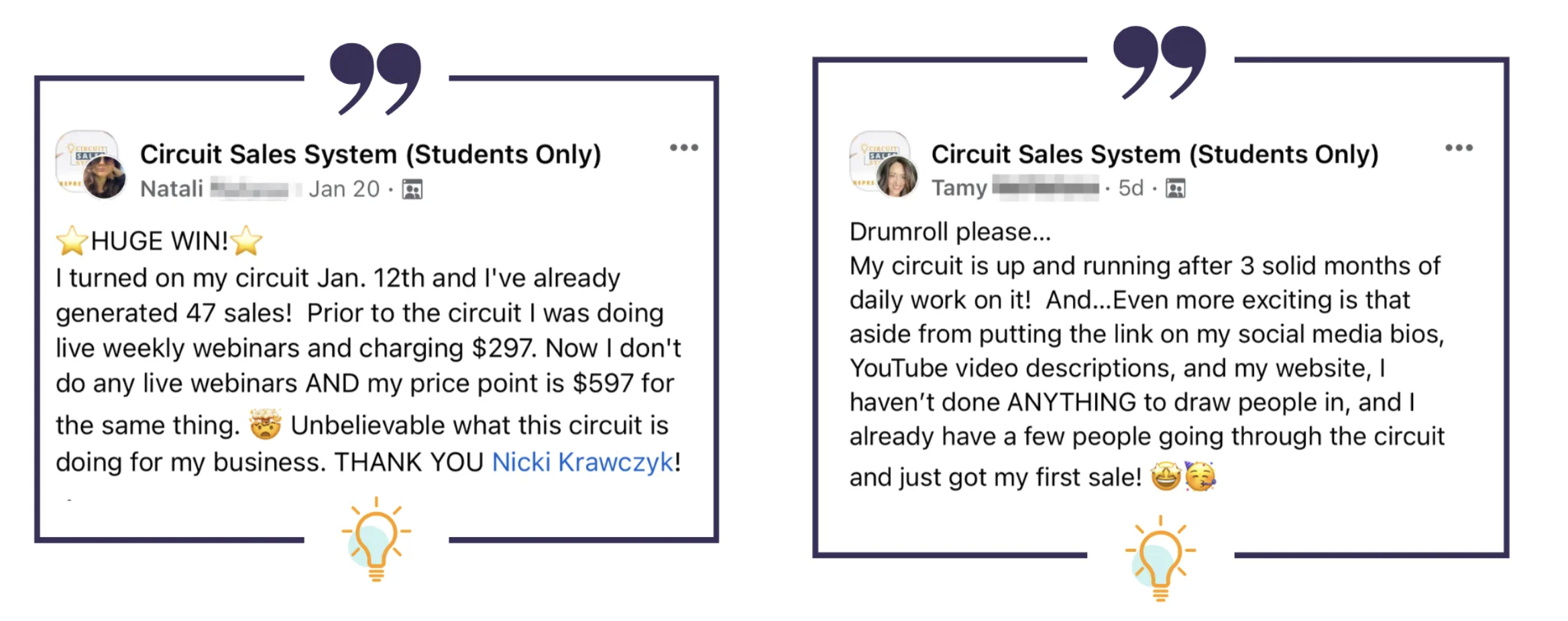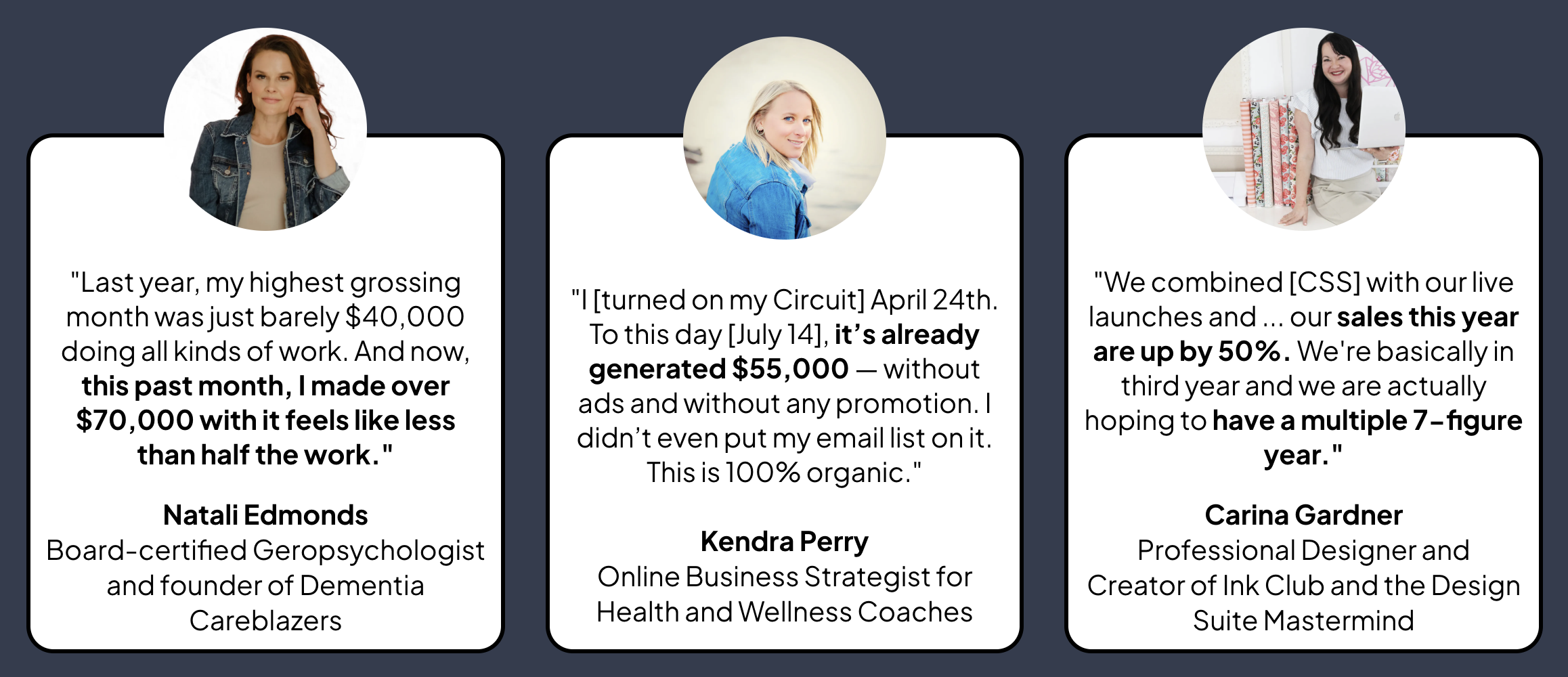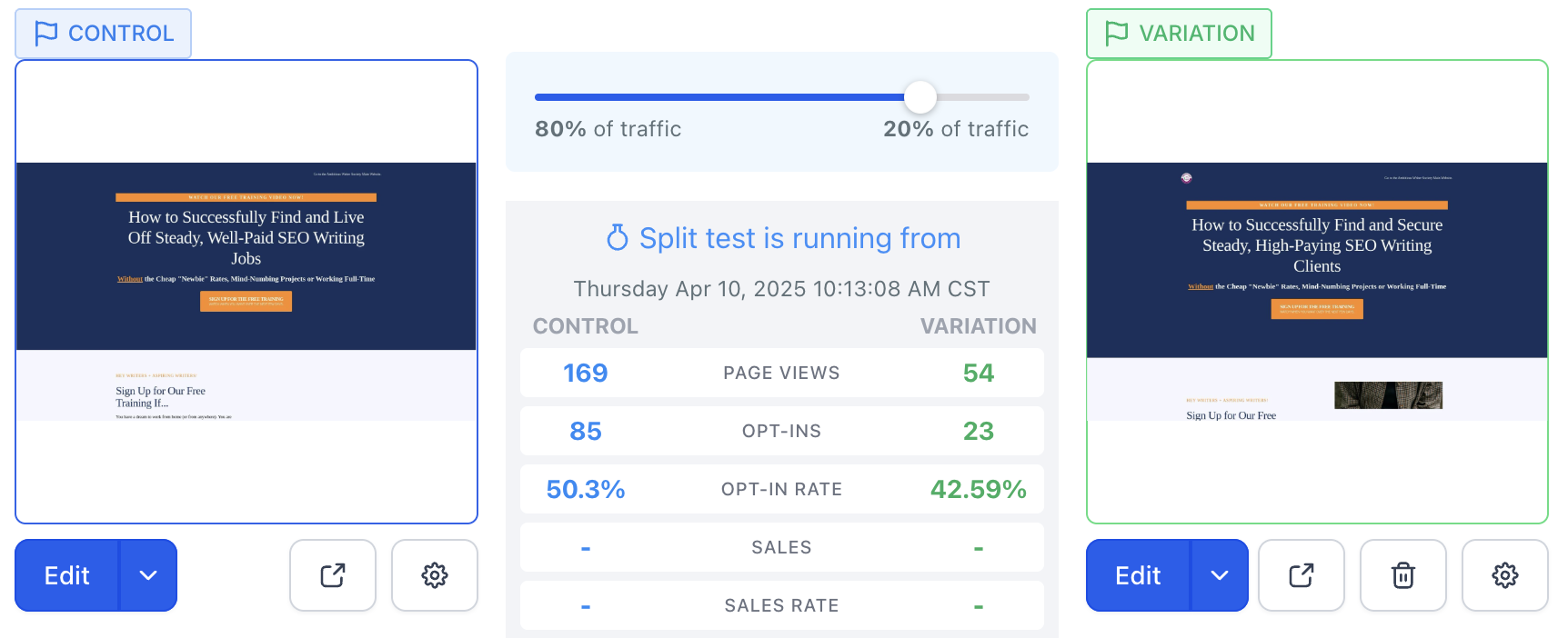A Successful Marketing Funnel Example for Your Online Course
Why your program isn’t selling the way you want it to (yet), and how to automate your funnel to avoid live launching.
Affiliate links in this post. I may earn a commission on purchases made through these links at no additional cost to you.
-
The reasons a “great program” rarely sells itself (and what’s really holding your course back).
Key funnel stages every lead passes through (so you can guide them to buy, effortlessly).
Small tweaks in copy, timing or messaging that can double your sales.
My go-to example of a real-world, automated funnel that actually converts: the Circuit Sales System.
You’ve done the hard work: You’ve built your course, and it’s probably polished and packed with value… Maybe you’ve even launched it once or twice already. Yet, you’re not making sales the way you hoped.
For others, you haven’t even taken that first big step into selling because you’re stuck in the abyss between “I’ve built this amazing program” and “Hey! People are buying it.”
You know you need a strategy behind selling your course; not just “put it live and hope for the best.”
In this post, I will detail what it takes to create high-converting marketing funnels. And, I’ll show you one of my favorite marketing funnel examples that I use today for myself and other brands.
Should You Live Launch or Do Evergreen? Or Both? Or Neither?
Here’s some tough love for you: If you bank on the idea that “great content sells itself,” you’re not going to make great money.
But the word “launch" feels heavy. The pressure of a live event, the deadlines, the hype – it all makes your chest tighten. If you can avoid live launching, you gladly will.
And when you look around for marketing support and training, there’s a flood of promises: “This evergreen funnel makes me $100K/month while I sleep!” And you know that’s not the whole story.
Many of those claims are too good to be true, especially for beginners, solo course creators and those without a marketing machine behind them.
Whether you go live, evergreen or a mix, your course still needs a structure that guides people from interest to action.
Why Your Course Won’t Sell without a Funnel
Your ideal client doesn’t even know your course exists yet.
They might want the result you promise, but it’s not clear on why they should buy from you.
They might want it, but not right now.
Without a clear funnel guiding them from “browsing” to “ready to buy,” many leads will just drop off. And all of this leads to your frustration, doubts and the “what do I do now?” limbo.
But before we talk about the sophisticated tactics, let me step back and discuss: What is a marketing funnel? How does it work? How can it realistically help your course sell (without you exhausting yourself running live launches)?
What Is a Marketing Funnel? (And Why It Matters)
A marketing funnel is simply a path of “touchpoints” that interact with a lead or customer. There are all types of marketing funnels, but the most common for online coaches and online course creators tries to turn complete strangers into buyers.
It is the structure that takes someone who knows nothing about you and your course and gently guides them through the steps to purchase.
Common Types of Funnels to Sell Online Courses and Programs
Because there are different contexts and models, let me clarify a few things:
Live Launches: Big, flashy live launches try to build hype around a brand, program or promotion. Filled with campaigns, registrations, live webinars and open/close cart windows, the goal is to gain a ton of attention quickly (and hopefully a mass influx of sales within hours or days).
The Risk: Make-or-break moments; having so much riding on a single launch; big flops with low conversions.
Evergreen Funnels: Automated, evergreen systems aim to continually bring in leads, nurture them and convert (requiring little to no live involvement). They provide great scalability and far less stress for the business owner.
The Risk: Always-open systems lack urgency to convert; low conversion rates.
Now, if both of these “traditional” marketing funnel methods don’t seem right for you, you’re in the right place. Many online course creators (including myself) have realized that live launches and evergreen funnels don’t quite offer the urgency and conversion combo we’re looking for.
Luckily I’ve got an awesome hybrid marketing funnel example that blends the high-conversion and hype of live launches with the passive, automated convenience of evergreen.
Let’s get into that next!
Marketing Funnel Example (Higher Conversions + Automation)
As an experienced copywriter, I’ve seen all sorts of campaigns and funnels – some brilliant, some underwhelming. But one system that consistently stood out to me is the Circuit Sales System (CSS).
I first encountered this system back in 2020 when it was used to sell an online copywriting course. At the time, I was much less business-savvy than I am today, but in hindsight, the funnel itself was eye-opening. I didn’t realize what was going on when I was in it, but it got me excited to spend $397.
A free video training introduced me to the world of copywriting, and the follow-up emails – motivating, inspirational and perfectly timed – convinced me to purchase before the deadline, in just a matter of days.
Years later, when I needed to create my own automated marketing system, I returned to the one that got me excited to invest in training: the Circuit Sales System.
Created and perfected by copywriter Nicki Krawczyk and digital marketer Allie Bjerk, the CSS has helped countless online course creators turn leads into paying students.
Learn more about the Circuit Sales System here.
How the Circuit Sales System Works
For clarity, here are a few notes about how the whole system works and what it looks like from a business owner’s perspective and that of a customer. To learn more about what the Circuit Sales System entails and what’s included, check out this review.
From the Lead’s Perspective
Each individual lead is on their own timeline. The system gives them a deadline to convert, creating a sense of urgency without requiring you to do anything live.
Instead of hoping leads take action, the CSS guides them through the funnel with automated touchpoints that encourage action at the right moment.
From an Operational Perspective
Nothing in the Circuit Sales System requires live effort once it’s built:
Lead magnets, video trainings and emails are all pre-created.
Deadlines, reminders and follow-ups are predetermined and automated.
Once someone signs up, the system runs itself.
From a Timeline Perspective
The Circuit Sales System is designed to be a long-term, self-contained system.
A full system build-out can guide a non-purchasing lead for 2 years or more. Once they convert, they can jump into your existing post-purchase funnel.
Like a circuit, the funnel can also:
Upsell additional programs.
Downsell for those not ready for premium offers.
Reignite excitement during different enrollment cycles.
All of this happens automatically as soon as a lead opts into your system.
Results from Previous Coaches and Course Creators
Photo credit: The Circuit Sales System
The creators and students of the Circuit Sales System have tested and improved this funnel extensively.
Many aim for:
3 course sales per day
3-4% conversion rates, which is higher than a typical online course campaign funnel
Imagine what it could mean for your business to hit 3 sales a day (on autopilot)!
Learn more about the Circuit Sales System here.
The Disadvantages You Should Know About
No marketing funnel is perfect, and the Circuit Sales System has some considerations:
Lots of Work Upfront
Casually referred to as a “behemoth” by course customers, building out the Circuit Sales System requires you (or a CSS-certified copywriter) to script out the video training, emails, landing pages and more.
The course provides detailed prompts to guide you through this process and really clarify your business strategy.
Best Suited for Online Course Creators or Coaches
While the system can incorporate live elements through “circuit enhancements,” it works best for those selling an online course or program.
Many business owners who sell higher-ticket courses often rely on sales or onboarding calls. Although it’s possible to integrate some of your existing live processes, the Circuit Sales System is designed for scalable, automated 24/7 operation.
Even without live calls, the funnel’s preset messaging is optimized to encourage conversions and move leads toward purchase. In many cases, business owners end up dropping their live sales calls once they set up their circuit.
Even with these caveats, the payoff is a fully automated, high-converting marketing funnel – one that helps you consistently sell your course without the stress of live launches.
Photo credit: The Circuit Sales System
Access more Circuit Sales System testimonials when you sign up for their free training video.
Marketing Funnel Metrics to Track
Knowing your numbers turns your funnel from guesswork into a predictable sales engine. Here are the core metrics every course creator should track (and what “good” numbers) look like.
Conversion Rate (Opt-In to Purchase)
What it means: The percentage of leads who go from signing up to purchasing.
Why it matters: It shows how effectively your funnel turns leads into revenue.
Benchmarks: Average funnels convert at around 2-4%, while top performers reach 5-10%. Anything under 1% suggests weak messaging, problems with the offer itself or poor nurture.
Email Open Rate and Click Rate
What it means: Open rate shows who’s opening the email; click rate shows who’s engaging.
Why it matters: Your email sequence is where most conversions happen.
Benchmarks: For course creators, aim for 30-50+% opens and 3-7% clicks. Small lifts here can dramatically improve revenue down the line.
Cost per Lead (CPL)
What it means: Your average cost to acquire one new lead.
Why it matters: It tells you how efficiently you’re spending to fill your funnel.
Benchmarks: Keep CPL in line with your offer price and conversion rate. For example, if your course sells for $500 and converts at 4%, your CPL should stay below $20 to remain profitable.
ROI per Funnel Loop
What it means: Measures the total return from your funnel.
Why it matters: It reveals if your funnel is actually profitable.
Benchmarks: A positive ROI is good; 2-5X return is great. Track ROI for each funnel loop (lead magnet to course sale to upsell) to see where to optimize.
Outside the Funnel: Track Paid and Organic Metrics
If you’re driving traffic through ads, SEO or social, also watch:
Cost per click (CPC)
Cost per acquisition (CPA)
Lead quality from each channel
Organic traffic growth and bounce rate
These insights show which traffic sources successfully fuel your funnel.
Marketing Funnel Examples to Improve Metrics and KPIs
Here are a few extra tips to improve your funnel conversion rates. Some are easy to tweak and others take more effort to optimize:
Personalized purchase deadlines to instill urgency: This involves some technical setup using cookies, pixels, etc. While you may find lots of deadline vendors on the market, only a few offer all of the functionalities you need to ensure every lead has their own unique deadline.
Automated nurture and re-engagement sequences: Aside from the direct response sales emails you send, your marketing funnel should also include well-timed nurture emails (that leads won’t unsubscribe from) and re-engagement emails ahead of a new enrollment deadline.
Built-in structure for testing subject lines and copywriting: Once your entire marketing funnel is built out, periodic metric checks are recommended to ensure your system is converting well. Because even small tweaks – like changing an email send time – can double conversions when your funnel runs 24/7.
How to Find the Gaps That Are Costing You Sales
Once your funnel is live, your job shifts from creation to optimization. The goal isn’t to overhaul everything, but rather, to identify small points of friction that are quietly costing you sales.
How to Read Your Funnel Data
Look at your analytics and ask:
Where are people dropping off? Is it after the lead magnet, during the email sequence or on the sales page?
Are your emails getting opened and clicked? If not, the problem might be your subject lines or timing (not your offer).
Are page visitors scrolling and staying long enough to read your pitch? Heatmaps and scroll-depth tracking can reveal where interest fades.
Simple Optimization Suggestions
You don’t need a full redesign to improve conversions. Here are some small things you can do that can instantly improve conversions for your funnel:
Sharpen your hook. Make the benefit or transformation crystal clear.
Tighten your CTA. Tell them exactly what to do next (and why now).
Make a better offer. If your audience wants “freedom,” but your copy sells “features,” you’ll lose resonance and revenue.
Automation That Keeps Improving
Here’s where the Circuit Sales System (CSS) stands out. Once you’ve refined your funnel, the CSS continues to work in the background by:
Re-engaging non-purchasers with subsequent, prewritten marketing circuits.
Delivering timed follow-ups that feel personalized (thanks to great copy), not robotic.
Automatically re-routing leads into new campaigns or offers if they didn’t buy the first time.
The result? You’re not manually chasing sales. Your marketing system is doing much of the heavy lifting for you, while you focus on teaching, creating or simply resting.



